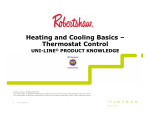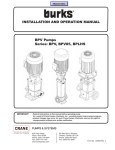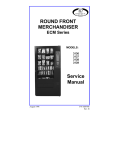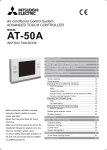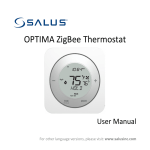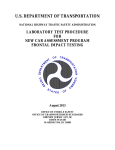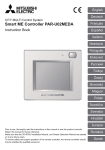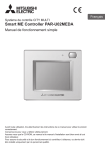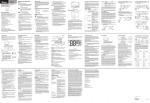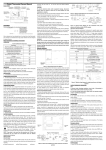Download Robertshaw 9710 Owner`s manual
Transcript
352-00021-004 Rev B COMPRESSOR PROTECTION The thermostat provides a 4-minute delay after shutting off the heating or cooling system before it can be restarted. This feature will prevent damage to your compressor caused by rapid cycling. Note that this delay also applies to the heating system control. It does not provide a delay when there are power outages. You can select the function on or off at the configuration. Programmable Thermostat TEMPERATURE RANGE Owners Manual Model: RS3210 Series This thermostat can be programmed between 45ºF and 95ºF (7ºC and 35ºC). However, it will display room temperatures from 30ºF to 99ºF (0ºC and 37ºC). HI will be displayed if the temperature is higher than 99ºF (37ºC), and LO will be displayed if the temperature is lower than 30ºF (0ºC).This thermostat will automatically shut down in Heat mode if the temperature rises above 95ºF (35ºC), and automatically shut down in Cool mode if the temperature drops below 45ºF (7ºC). NOTE: If the thermostat measures a temperature over 99ºF(37º), HI will be displayed on the LCD. If the temperature is below 32ºF(0º). and LO will be displayed on the LCD. POWER FAILURE Whenever the main power is interrupted or fails, the backup battery power will maintain the current time. This thermostat also contains permanent memory that will retain your program setting through power outages. FEATURES POWER SUPPLY The thermostat is powered by 24 VAC and has battery backup. BATTERY WARNING Structure of thermostat and explanation of the keypads We are pleased you have selected our wall thermostat. Our products are manufactured to high quality standards and are designed for years of service. Read This Before Installing Thermostat OPERATION YOUR THERMOSTAT FUNCTIONS WITH Description Fresh alkaline batteries should provide about one year of service. When the batteries become weak, BATT will alternate on the display with the current time. When this message occurs, install 2 new AA batteries. You have approximately 1 minute to change the batteries and keep the thermostat’s clock and program settings. Once the batteries have become too weak to ensure proper operation, your system will be turned off, and the display will be cleared except for BATT flashing on the LCD display. 6. Push excess wire into wall and plug hole with a fire resistant material (such as fiberglass insulation) to prevent drafts from affecting thermostat operation. Yes Two Stage Heat & One Stage Cool Yes Standard Heat Only Systems Yes Millivolt Heat Only Systems – Floor or Wall Furnaces Yes Standard Central Air Conditioning Yes Gas or Oil Heat Yes • Slotted screwdriver(s) • Small Phillips screwdriver • Hammer • Electric drill and 3/16” bit • Two1.5V (AA) size alkaline batteries (included) Electric Furnace Yes CAUTION: Hydronic (Hot Water) Zone Heat-2 Wires Yes Hydronic (Hot Water) Zone Heat–3 Wires No To prevent electrical shock and/or equipment damage, disconnect electric power to system at main fuse or circuit breaker box until installation is complete. Before removing wires from old thermostat, label each wire with the terminal designation it was removed from. 1. Shut off electricity at the main fuse box until installation is complete. Ensure that electrical power is disconnected. 2. Remove old thermostat: A standard heat/cool thermostat consists of three basic parts: All programming is normally performed at your thermostats location. a. The cover, which may be either a snap-on or hinge type. ARMCHAIR PROGRAMMING b. The base, which is removed by loosening all screws. You can program your thermostat before installation by inserting the batteries and following the instructions starting with the installer/configuration menu. This can be done while you relax in your favorite chair and is a very good way to familiarize yourself with all the functions of your thermostat. c. The switching subbase, which is removed by unscrewing the mounting screws that hold it on the wall or adapter plate. The following time and temperature settings are pre-programmed into the thermostat: 3. Remove the front cover of the old thermostat. With wires still attached, remove wallplate from the wall. If the old thermostat has a wall mounting plate, remove the thermostat and the wall mounting plate as an assembly. 4. Identify each wire attached to the old thermostat. Time Heat Cool 1 6:00 am 68ºF(20ºC) 78ºF(26ºC) 5. Disconnect the wires from the old thermostat one at a time. DO NOT LET WIRES FALL BACK INTO THE WALL. 2 8:00 am 60ºF(16ºC) 85ºF(29ºC) 6. Install new thermostat using the following procedures. 3 4:00 pm 68ºF(20ºC) 78ºF(26ºC) WARNING 4 10:00 pm 60ºF(16ºC) 82ºF(28ºC) Do not use on circuits exceeding specified voltage. Higher voltage will damage control and could cause a shock or fire hazard. Do not short out terminals on gas valve or primary control to test. Incorrect wiring will damage thermostat and could cause personal injury and/or property damage. Temperature in Fº (Cº) 3. Place base over hole in wall and mark mounting hole locations on wall using base as a template. This thermostat includes two #8 slotted screws and two wall anchors for mounting. To install your thermostat, you should have the following tools and materials. What You Need: Standard Heat & Cooling Systems INSTALLATION 1. Remove the packing material from the thermostat. Gently pull the cover straight off the base. Forcing or prying on the thermostat will cause damage to the unit. 5. Fasten base loosely to wall, as shown in Figure 1, using two mounting screws. Place a level against bottom of base, adjust until level, and then tighten screws. (Leveling is for appearance only and will not affect thermostat operation.) If you are using existing mounting holes, or if holes drilled are too large and do not allow you to tighten base snugly, use plastic screw anchors to secure subbase. INSTALLATION REMOVE THE MYLAR LABEL FROM THE LCD DISPLAY WINDOW. Attach Thermostat Base to Wall 4. Move base out of the way. Drill mounting holes. Yes Read the entire installation section of this Owner’s Manual thoroughly before you begin to install or operate your thermostat. All wiring diagrams are for typical systems only. Refer to equipment manufacturer’s instructions for specific system wiring information. NOTE: If you plan to be away from the premises over 30 days, we recommend that you replace the old batteries with new alkaline batteries prior to leaving. Yes IMPORTANT This thermostat is configured from the factory to operate a heat/cool, fossil fuel (gas, oil, etc.), forced air system. It is configured correctly for any system that DOES NOT require the thermostat to energize the fan on a call for heat. If your system is an electric heat or heat-pump system that requires the thermostat to turn on the fan on a call for heat, locate the ELEC/GAS switch on the back of the thermostat (see Figure 1) and switch it to the ELEC position. This will allow the thermostat to energize the fan immediately on a call for heat. If you are unsure if the heating/cooling system requires the thermostat to control the fan, contact a qualified heating and air conditioning service person. When the thermostat is configured for heat pump, the thermostat will always power the circulator fan on a call for heat in the Heat mode. The ELEC/GAS switch must be set to match the type of auxiliary heat your system uses for proper operation in the Emergency mode. 2. Connect wires beneath terminal screws on base using appropriate wiring schematic (see Figures. 2 through 6). Heat Pump (With Auxiliary or Emergency Heat) This Thermostat will NOT control 110/220 Volt systems. Figure 1. Electric/Gas Switch (Fan Option) CAUTION: Once the BATT display occurs, the thermostat is shut down, and your system will no longer operate. In this condition, there is no temperature control. NOTE: The backlight will not function when the thermostat is in low battery condition. Heat Pump (No Auxiliary or Emergency Heat) Program Number Selector Switches Figure 2. Thermostat base Figure 3. Typical wiring diagram for single transformer heat pump systems Figure 4. Typical wiring diagram for two transformer heat pump systems with NO safety circuits Figure 5. Typical wiring diagram for two transformer heat pump systems with safety circuits in BOTH systems Cooling System • Tap DAY to advance one day at a time. 1. Move System switch to select the Cool mode. 2. Press to adjust thermostat setting below room temperature. The blower should come on immediately on high speed, followed by cold air circulation. The display should show STG1. 3. Press to adjust the temperature setting above room temperature. The cooling system should stop operating. • When finished press HOLD/RUN to return to normal mode. After 15 seconds, the thermostat will return to normal automatically. CONFIGURATION MENU INSTALLER/CONFIGURATION MENU Step Figure 6. Typical wiring diagram for single transformer multi-stage systems Press Button Displayed (Factory Default) Use the terminal output information below to help you wire the thermostat properly for your heat pump system. After wiring, see CONFIGURATION section for proper thermostat configuration. THERMOSTAT TERMINALS (HEAT PUMP) SYSTEM Heat Pump 1 L Malfunction C* 24 Volt (common) R 24 Volt Emergency (hot) E/W1 Emergency Mode 1st stage W2 HP 1 and Emergency 2nd stage Y1 Heat and Cool mode 1st stage (compressor) G Blower/Fan Energized on call for Heat and Cool Set GAS/ELEC switch for Emergency mode O Energized in Cool Mode B Energized in Heat Emergency mode Comments Selects Single stage, Multi-stage or Heat SS1, HP2, Pump (Single stage or HP1 2-stage) System Configuration MS 2 2 F (DIFF)2 1,3 DIFF (one stage) 3 F (BLIT)on off BackLight 4 F (SP2)2 1,3 DIFF (Two Stage) 5 F (TEMP)F C Selects temperature display °F or °C • Press once. During Auto Programming, the display will change as shown. 6 F HOUR(12) 24 Selects time format display 12 hours or 24 hours • The thermostat will be programmed for all 7 days of the week as shown below. 7 F COMP(OFF) ON Selects Compressor Lockout OFF or ON 1,2 Select 1 to reset to factory defaults 8 F FACT(0) The configuration menu allows you to set certain thermostat operating characteristics to your system or personal requirements. Set System switch to OFF, then simultaneously press up and down keys to enter configuration menu. The display will show the first item in the configuration menu. The configuration menu table summarizes the configuration options. An explanation of each option follows. Press F key to change to the next menu item. To exit the menu and return to the program operation, press Hold/Run key. If no keys are pressed within fifteen seconds, the thermostat will revert to normal operation. Note: To prevent static discharge problems, touch side of thermostat to release static build-up before touching any keys. If at any time during testing your system does not operate properly, contact a qualified service person. Fan Operation 2) Fast or slow cycle selection (one stage) If your system does not have a G terminal connection, skip to Heating System. 1. Turn on power to system. 2. Move Fan switch to ON position. The blower should begin to operate. 3. Move Fan switch to AUTO position. The blower should stop immediately Heating System 1. Move System switch to Heat mode. If the auxiliary heating system has a standing pilot, be sure to light it. 2. Press to adjust thermostat setting to 1ºF/1°C above room temperature. The heating system should begin to operate. The display should show STG1. However, if the setpoint temperature display is flashing, the compressor lockout feature is operating (see Configuration Menu, item 5). 3. Adjust temperature setting to 3ºF/3°C above room temperature. If your system configuration is set at MS2, HP2 or HP1, the auxiliary heat system should begin to operate and the display should show STG1+2. 4. Press to adjust the thermostat below room temperature. The heating system should stop operating. Emergency System EMER bypasses the heat pump to use the heat source wired to terminal E on the thermostat. EMER is typically used when compressor operation is not desired, or you prefer back-up heat only. 1. Press System switch to select Heat mode. then press EMER key. EMER will show on the display. 2. Press to adjust thermostat setting above room temperature. The auxiliary heating system will begin to operate. The display will show STG1 EMER to indicate that the auxiliary system is operating. 3. Adjust temperature setting to 2ºF/2°C above room temperature. The auxiliary heat system should begin to operate and the display should show STG1+2. 4. Press to adjust the thermostat below room temperature. The auxiliary heating system should stop operating. Your thermostat is capable of holding up to 4 separate programs for each day of the week. You can program all weekdays, Monday to Friday, to the same 4 programs as shown in the table, or each weekday can have a different set of 4 programs. Similarly weekend programs, (Saturday and Sunday) can be the same 4 programs or each weekend day can have a different set of 4 programs. F 1) Single Stage, Multi-stage or Heat Pump System Configuration This control can be configured for Heat Pump or two stage heat/one stage cool multi-stage operation. The display indicates MS 2 (default for multi-stage mode) in the display. The multi-stage configuration can be toggled to SS1, or HP1 by pressing the up or down key. In multi-stage configuration, EMER mode is not used. In this model, the HP2 is not used. CHECK THERMOSTAT OPERATION Studies conducted by the Department of Energy estimate that setting your thermostat back 10ºF (6°C) for two 8-hour periods during winter can reduce your fuel bill by as much as much as 33%. Setting your thermostat up 5ºF (3°C) for two 8-hour periods during summer can reduce your fuel bill up to 25%. 1 Heat Pump Terminal Outputs Refer to equipment manufacturer’s instructions for specific system wiring information. You can configure the thermostat for use with the following heat pump system types: HEAT PUMP TYPE 1 1. Single stage compressor system; gas or electric backup. This thermostat is designed to operate a single-transformer system. If you have a two-transformer system, cut and tape off one transformer. If transformer safety circuits are in only one of the systems, remove the transformer of the system with NO safety circuits. If required, replace remaining transformer with a 75VA Class II transformer. After disconnecting one transformer, the two commons must be jumpered together. Press down key to select Auto Programming 3) Select backlight function OFF or on Your thermostat is pre-programmed to meet the ENERGY STAR™ guidelines for energy efficiency. Note that it is easier to modify these programs than to program the thermostat manually. Temperature in Fº (Cº) Program Number 6) Selects time format to display in 12-hour or 24-hour clock 7) Select compressor lockout (COMP OFF or ON) Selecting COMP ON will cause the thermostat to wait 4 minutes before turning on the compressor if the heating and cooling system loses power. It will also wait 5 minutes minimum between cooling and heating cycles. This is intended to help protect the compressor from short cycling. Some newer compressors already have a time delay built in and do not require this feature. Your compressor manufacturer can tell you if the lockout feature is already present in their system. When the thermostat compressor time delay occurs it will flash the setpoint for about four minutes. Heat Cool 1 6:00 am 68ºF(20ºC) 78ºF(26ºC) 2 8:00 am 60ºF(16ºC) 85ºF(29ºC) 3 4:00 pm 68ºF(20ºC) 78ºF(26ºC) 4 10:00 pm 60ºF(16ºC) 85ºF(28ºC) • Refer to Manual Programming for entering or changing the programs. PROGRAMMING Before programming or changing programs, use this Personal Program Schedule to determine which times and temperature settings will best satisfy both your comfort and energy saving requirements. Use a pencil so you can revise yours records each time you change your temperature settings. Heating DAY Mon Tue Wed Thu Fri Sat 4) Fast or slow cycle selection (two stage) 5) Select °F or °C readout. When you change this parameter, the programming returns to default. You have to set the program again. Time Sun Program 1 Time Temp Time Temp Time Temp Time Temp Time Temp Time Temp Time Temp Program 2 Time Temp Time Temp Time Temp Time Temp Time Temp Time Temp Time Temp Program 3 Time Temp Time Temp Time Temp Time Temp Time Temp Time Temp Time Temp Program 4 Time Temp Time Temp Time Temp Time Temp Time Temp Time Temp Time Temp Program 1 Time Temp Time Temp Time Temp Time Temp Time Temp Time Temp Time Temp Program 2 Time Temp Time Temp Time Temp Time Temp Time Temp Time Temp Time Temp Program 3 Time Temp Time Temp Time Temp Time Temp Time Temp Time Temp Time Temp Program 4 Time Temp Time Temp Time Temp Time Temp Time Temp Time Temp Time Temp Cooling DAY Mon Tue Wed Thu Fri Sat Sun 8) Select 1 to reset to factory defaults. Manual Programming Setting Time And Day • Your thermostat can be programmed for weekdays and weekends. Use Weekday/Weekend Programs to enter or revise programs to match your Personal Program Schedule. The same steps are used when entering programs for the first time or revising programs entered during Auto Programming. Remove the mylar label covering the LCD display window before operating thermostat. • Initial display after power-up. The temperature will update after a few seconds. • During Time and Day Setting mode, the temperature and program display will go blank. • Press and hold HOUR to rapid advance to the current hour. Tap to advance one hour at a time. Note the AM/PM indicator, as the display will cycle through 24 hours. • Press and hold MIN to rapid advance to the current minute. • Tap to advance one minute at a time. • Familiarize yourself with Manual Programming, so that you can easily modify your programs as your comfort needs change. The example below demonstrates the Manual Programming method. NOTE: 1. The program time can be set in 10-minute increments, and remains the same for both Heat and Cool programs. 2. The program temperature can be set in increments of 1ºF (1ºC). 3. The heat setpoint cannot be set higher than the cool setpoint, and the cool setpoint cannot be set lower than the heat setpoint. 352-00021-004 Rev B 5/08 4. If the system selector is in AUTO mode, the current operating mode will be used for programming. 5. After 15 seconds without a key press, the thermostat will return to normal display mode. 6. When setting the program time, note the AM/PM indicator. 7. With the Auto Recovery feature enabled, you do not need to set your comfort program times early. Auto Recovery will turn your system on so that the room is comfortable at the program time. Weekday/Weekend Programming Weekday Programs Display Reads • Normal display of time, temperature, and day of the week. • Selects days Mon. to Fri. for same set of 4 programs each day. Step 3 The System Selector switch on the front of the thermostat determines the operating mode of the thermostat. You may select COOL, OFF, HEAT, or AUTO. In order to take full advantage of this thermostat’s features, we recommend using the AUTO mode. Refer to the Auto Season Changeover information for using this feature. Temporary Manual Override • Press and hold until 6:00 is displayed. • Note AM/PM To temporarily change the current set temperature without affecting your program: Step 4 • Press once to change temperature to 69ºF. • Weekday program 1 is complete. • Press PROG to move to program 2, 3, and 4 and follow the same steps. to insert or change time and temperature of other programs. • Press and hold or for less than 1 second to enter Manual Override mode. • Press and temperature. to change to your desired new • Press to RUN to normal mode or wait 15 seconds for it to return automatically. • The current program number will flash to signify the Temporary Override. • Selects weekend days Sat. and Sun. for same set of 4 programs each weekend day. • Follow steps 2-4 to enter programs. At the next program change, the Temporary Override is canceled, and the next program temperature becomes the setpoint temperature. Similar to weekday programming. to insert weekend programs. Individual Day Programming To program each individual day separately by a differnet set of programs, first select day by displaying the day of program, then insert the desired times and temperatures. Display Reads • Mon. to Fri. are selected. Mon. to Fri. will have same programs. • Sat. to Sun. will have same programs. • Mon. is seleted, program for Mon. only. Use System Selector Switch The Fan switch should normally be set in the AUTO position. The fan will be turned on along with normal operation of your system. In a normal gas or oil furnace, the fan will be turned on by your furnace after its warm-up delay. For electric heat, air conditioning, and heat pump operation, the fan will turn on with the system. To run the fan continuously, slide the Fan switch to the ON position. • Program indicator (1) is displayed. • 68ºF is displayed. • Mon. to Fri. is displayed. Press OPERATION Fan Switch Step 2 Use • Set temperature is shown above current room temperature. NOTE: Anytime you install or remove the thermostat from the wallplate, slide the System Selector to the OFF position to prevent the possibility of a rapid system on-off. Step 1 Use • Press less than 1 second. to enter programs for Monday. Similarly • Tue. to Sun. can be selected. Display the day to be programmed and use to enter programs. NOTE: Another approach to programming is to first program all weekdays Mon. through Fri. and Sat. and Sun. as same programs. Then, display and change the programs of only those days which willhave different programs. Reviewing Programs You may want to review the programs to see that the settings are compatible with your lifestyle. • Normal display of current time, day of week temperature, and day of week. • 1st weekday program is displayed. • Program indicator (1) appears. • Mon to Fri indication appears. • Continue pressing to view each day. • Continue pressing to view each period. If you are armchair programming the thermostat, turn the System Selector to the OFF position Reviewing the Current Temperature Setting Current time and temperature. To end the Temporary Manual Override: • Press and wait for HOLD to display on the LCD. • Press HOLD key twice. This will return the set temperature to the current program set temperature. NOTE: The Auto Season Changeover feature will not operate while the thermostat is in Temporary Manual Override. Refer to the Auto Season Changeover feature for more information. Permanent Override or a Designated Day Override To hold your Manual Override for vacation or until a Designated Day. • Press to make the current program temperature the HOLD temperature. HOLD will be displayed on the LCD, and the program number will disappear. • Follow the Temporary Manual Override instructions above to change the Permanent Manual Override temperature. • You can confirm the setpoint by pressing HOLD/RUN for less than 1 second. • Press again. Hold day will be displayed on the LCD and the clock will disappear • Press Day key to add override days. Press Hour key to reduce override days. • Follow the Temporary/Designated Day Override instructions above to change the Permanent Manual Override temperature. To End Override: Under Permanent Override press hold/return key twice. Under a Designated Day Override press the hold once. The thermostat will return to the current program, and the HOLD display will be canceled. NOTE: The Auto Season Changeover feature will not operate while the thermostat is in permanent Manual Override. Refer to the Auto Season Changeover feature for more information. Auto Season Changeover When the System Selector is in AUTO position, the thermostat will automatically change between heating and cooling systems, depending on your program. We recommend keeping your programmed heating and cooling temperature at least 4ºF (2ºC) apart to allow the Auto Season Changeover to occur when the appropriate temperature span has been reached. If your heating and cooling programs have setpoints that are close, there is a built-in program to prevent the thermostat from going into Temporary, Designated Day Override, or Permanent Override, as these overrides are energy saving settings. Auto Season Changeover will still function in Home Today mode, as this is a comfort setting. For example, you may have the following temperatures programmed at a given time: Heat Set Temp=68ºF, Cool Set Temp=78ºF. If the room temperature rises above 78ºF, then the thermostat will automatically change to cool mode and turn on the air conditioner. Likewise, the thermostat will automatically change to heat mode and turn on heat when the room temperature falls below 68ºF. HOME TODAY This feature allows you to quickly and temporarily override your energy saving program setting on days when you are normally away from home with one key press. • Press to enter the Home Today override. When in Home Today override, the thermostat will use the previous manual override temperature setpoint for the remainder of the day. • The display will alternate between HOME and the current time. • When pressed during the day, the thermostat will remain in Home Today mode until the first program of the next day. • If the system is changed between Heat and Cool modes (either manually or by Auto Season Changeover) during the Home Today Override period, the setpoint temperature will be automatically update. It will automatically change from the lowest cool program setpoint to the highest heat program setpoint. • Press to exit Home Today mode before the schedule ending time. HOME is no longer displayed on the LCD screen, and the thermostat returns to the current program. • You can manually change the setpoint temperature while in Home Today mode. Refer to the Temporary Manual Override instructions. Manually changing the set temperature while in Home Today mode will not affect the Home Today ending time, however, the set temperature will not change automatically with a manual or automatic change between heating and cooling. Energy Monitor • The Energy monitor feature measures and stores the amount of time the heating and air conditioning system operates. Usage can be displayed for Today (since 12 am), Yesterday, This Week (since Monday), Last Week (last Monday through Sunday), and Total (up to 999 Hrs). By monitoring your energy usage, you see how much the setback periods are saving, and you can test program adjustment to save even more. To review energy usage, press to cycle through Today, Yesterday, This Week, Last Week, and Total. Press again to return to normal mode, or wait 15 seconds for the display to return to normal mode. You can also return to normal mode at any time by pressing RUN. • For example: This LCD display shows Today’s usage to be 10 Hours, 26 minutes. • Press and hold for 3 seconds to reset the Energy Monitor’s counters. The display will blink, and counters will be cleared to zero. NOTE: Clearing the Energy Monitor counter will also clear the Filter Monitor counter, as Filter usage and Total Energy usage are the same. Also, clearing the Filter Monitor counter will clear ALL Energy Monitor counters as well. Filter Monitor Your thermostat also keeps a record of the number of hours your filter has been in use. To maximize your system’s performance and energy efficiency, change or clean your filter regularly. • When the total system run time for heat and cool reaches 500 hours, you need to clean or change your system’s filter. FILT will continue to flash until the counter is set back to zero. • Press FILTER to review total filter usage. The display will blink FILT, then show the Filter Monitor counter. After 15 seconds, the display will return to normal mode, or you can hit RUN to exit immediately. The Filter Monitor will display up to 999 hours and 59 minutes of usage. • To reset the Filter Monitor counter, depress FILTER for 3 seconds. The display will blink, and the counter will be reset to zero. NOTE: Clearing the Filter Monitor counter will also clear ALL Energy Monitor counters, as Filter usage and Total Energy usage are the same. Also, clearing the Energy Monitor counters will clear the Filter Monitor counter as well. Auto Recovery Auto Recovery calculates how early to turn your system back on, so that the room temperature is already comfortable by the start of the program period. Auto Recovery works in both Heat and Cool modes. • When the thermostat is in Auto Recovery mode, the display will alternate RECO with time, and the program indicator will flash. 352-00021-004 Rev B 5/08 • Auto Recovery can be disabled by sliding the Recovery switch on the circuit board to disable. • Auto Recovery will not operate if Permanent Hold or Temporary Hold is in operation. • Auto Recovery can be canceled manually if HOLD is pressed during the recovery process. If a recovery process is canceled manually then the recovery process will not start again until the next program period starts (an exception is that if time or program is changed then the thermostat will check Auto Recovery conditions immediately). • Auto Recovery will be canceled and change to next period. • Auto Recovery will be canceled and change to Home Today mode if HOME TODAY is pressed during the recovery process. TROUBLESHOOTING Problem Solution SCRAMBLED OR DOUBLE DISPLAY (numbers over numbers) 1. Remove clear mylar sticker. NO DISPLAY 1. Check battery connections and batteries. 2. Press the reset button once with a small pin and hold for two seconds then reprogram. ENTIRE DISPLAY DIMS 1. Replace batteries. PROGRAM DOES NOT CHANGE AT YOUR DESIRED SETTINGS 1. Check that the time is set properly to AM or PM. 2. Check that the thermostat is not in HOLD or Home Today mode. 3. Check for the correct day settings. AUTO/FAN DOES NOT TURN ON 1. Move Elec/Gas selector to opposite position. 2. The thermostat may be in Auto mode. Look for AUTO on the LCD display. If the heat or cool program temperatures are close, the thermostat requires a larger temperature change before switching systems. 3. There may be as much as 4 minute delay before the heat or cool system turns on. Wait and check. (Compressor protection delay) 4. Check your circuit breakers and switches to ensure there is power to the system. 5. Replace batteries. 6. Make sure your furnace blower door is closed properly. 7. Check the position of the Furnace or Heat Pump selector switches: Normal/O/B. ERRATIC DISPLAY 1. Press the reset button once with a small pin and hold for two seconds then reprogram. UNIT CONTINUES TO OPERATE IN THE OFF POSITION 1. Replace unit. THERMOSTAT PERMANENTLY READS E1, E2, E3, E4 1. Replace unit. Keyboard lock The keyboard can be locked to prevent unauthorized changes to the thermostat. To lock or unlock the keyboard, press and hold hold/run key for 3 seconds. The keyboard is locked when LOCK appears on the display. • When all keys are locked, LOCK will appear on the display for 1 second any time a key is pressed. Backlighting Your thermostat has an electroluminescent lamp that backlights the display for easy viewing in the dark. When any key is pressed the display is illuminated. The display will remain illuminated for 8 seconds after the last key is pressed. This allows the light to stay on if you need to operate several keys. NOTE: If the thermostat is in Low Battery warning condition, the backlight will not operate. Replace with 2 new AA alkaline batteries to restore the Backlight function. If you experience any other problems, contact Technical Support at: www.invensyscontrols.com or (800) 445-8299 Low Battery Warning Your thermostat has a two-stage lower battery warning system. When the batteries are first detected to be weak, the first stage low battery warning is indicated by BATT flashing on the LCD display. Replace the batteries with 2 new AA alkaline batteries. When the batteries become too weak for normal operation, the thermostat enters the second stage low battery warning which shuts down the thermostat. In this condition, BATT flashes alone on the display, and the thermostat will turn your system off. Your system will remain off until the batteries are replaced. NOTE: The thermostat will still keep the current Set Temperature and Filter run time in memory until new batteries are installed. After confirming that new batteries have been inserted, the thermostat will return to normal operation. Error Mode If the thermostat is unable to control your system due to an unexpected battery problem, the thermostat will enter Error Mode. In this condition, the thermostat flashes E1, E2, E3 or E4 on the LCD display, and shuts off your system. To correct this problem, replace the batteries with 2 new AA alkaline batteries, even if you have recently replaced them. Press the reset button once with a small pin and hold for two seconds then reprogram. If Error Mode returns, please contact us for further information. Warning Mode If the Malfunction Input (L) from the heat pump is active, the thermostat flashes E5on the LCD display. Auto Cut Off Your thermostat will automatically shut down in Heat mode if the room temperature rises above 95ºF (35ºC). It will shut down in Cool mode if the room temperature drops below 40ºF (4ºC). Two Year Limited Warranty Invensys Controls warrants to the original contractor installer or to the original consumer user that each new Robertshaw Product shall be free from defects in materials and workmanship under normal use and service for a period of two (2) years from the date of manufacture (“Warranty Period”). If any Product fails within the applicable Warranty Period, Invensys Controls shall, at its sole option, repair or replace the Product, provided that the Product is returned to Invensys Controls’ facility or designated agent within the Warranty Period, with transportation charges prepaid, and that the Product, upon examination by Invensys Controls, is found to conform to this warranty. The above warranty does not apply to: i) batteries; ii) improper installation; iii) Products that have been damaged, misused, neglected, mishandled, or altered in any manner whatsoever, and/or; iv) defects or damage that result from use of the Product in other than its normal and customary manner or in any manner not in accordance with Invensys Controls’ recommendations and/or instructions. Any and all costs of labor, thermostat removal, or reinstallation are not covered under this warranty and shall be the sole responsibility of the consumer or installer, as applicable. THE FOREGOING WARRANTY IS IN LIEU OF AND EXCLUDES ALL OTHER WARRANTIES, WHETHER VERBAL OR WRITTEN, EXPRESS OR IMPLIED INCLUDING, EXCEPT TO THE EXTENT PROHIBITED BY APPLICABLE LAW, THE IMPLIED WARRANTIES OF MERCHANTABILITY AND FITNESS FOR A PARTICULAR PURPOSE. IN NO EVENT SHALL INVENSYS CONTROLS BE LIABLE TO CONSUMER, CONTRACTOR OR ANY THIRD PARTY FOR ANY CONSEQUENTIAL, INCIDENTIAL, SPECIAL OR PUNITIVE DAMAGES ARISING FROM OR RELATING TO USE OF THE PRODUCT INCLUDING, BUT NOT LIMITED TO, LOSS OF GOODWILL, LOSS OF PROFIT OR REVENUE, AND PROPERTY DAMAGE, REGARDLESS WHETHER SUCH LOSS OR DAMAGE IS BASED IN CONTRACT, WARRANTY, TORT, NEGLIGENCE, STRICT LIABILITY, INDEMNITY, PRODUCT LIABILITY, OR OTHERWISE AND EVEN IF INVENSYS CONTROLS HAS BEEN ADVISED OF THE POSSIBILITY OF SUCH DAMAGES. Note that if your system has malfunctioned and no longer responds to thermostat controls, the Auto Cut-Off will have no effect. 191 E. North Avenue Carol Stream, Illinois 60188 www.invensyscontrols.com ©2008 Invensys Controls 352-00021-004 Rev B 5/08




